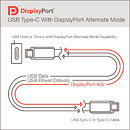Wednesday, April 29th 2020
VESA Releases Updated DisplayPort Alt Mode Spec
The Video Electronics Standards Association (VESA ) today announced that it has released version 2.0 of the DisplayPort Alternate Mode ("Alt Mode") standard. DisplayPort Alt Mode 2.0 provides seamless interoperability with the new USB4 specification published by the USB Implementers Forum (USB-IF), and fully enables all of the features in the latest version of the DisplayPort standard (version 2.0) through the USB Type-C (USB-C) connector. With DisplayPort Alt Mode, the USB-C connector can transmit up to 80 Gigabits per second (Gbps) of DisplayPort video data utilizing all four high-speed lanes in the cable, or up to 40 Gbps with simultaneous SuperSpeed USB data delivery. VESA anticipates first products incorporating DisplayPort Alt Mode 2.0 to appear on the market in 2021.
DisplayPort 2.0, which was introduced in June 2019, provides up to a 3X increase in data bandwidth performance compared to the previous version of DisplayPort, as well as new capabilities to address future performance requirements of displays. These include beyond-8K resolutions, higher refresh rates and high dynamic range (HDR) support at higher resolutions, improved support for multiple display configurations, as well as improved user experience with augmented/virtual (AR/VR) displays, including support for 4K-and-beyond VR resolutions. Featuring the highly efficient 128b/132b channel coding shared with USB4, DisplayPort 2.0 delivers a maximum payload of 77.37 Gbps across four lanes (up to 19.34 Gbps per lane)—supporting ultra-high display performance configurations such as an 8K (7680x4320) display with 60 Hz refresh rate with full-color 30 bpp 4:4:4 HDR resolution uncompressed, and 16K (15360x8460) 60 Hz display with 30 bpp 4:4:4 HDR resolution with compression. With the release of DisplayPort Alt Mode 2.0, all of these high-performance video capabilities are now available to the USB ecosystem."VESA's updated DisplayPort Alt Mode spec includes a number of under-the-hood developments—including updates to interface discovery and configuration as well as power management—to ensure seamless integration with the USB4 specification," stated Craig Wiley, senior director of marketing at Parade Technologies, and VESA board member and DisplayPort Alt Mode sub-group leader. "This major undertaking, which was several years in the making, could only be made possible through the combined efforts of VESA and the USB-IF. Through our latest collaboration with the USB-IF, VESA is now taking care of everything related to high-performance displays over USB-C, whether through a native DisplayPort or USB-C connector, or through tunneling of DisplayPort over the native USB4 interface. DisplayPort is also tunneled through the Thunderbolt interface, making it the de facto video standard across PC and mobile displays."
"USB Type-C is becoming the connector of choice in notebooks and mobile solutions. With the new DisplayPort Alt Mode 2.0 specification, USB Type-C now delivers compelling single-connector solutions for docking, gaming, AR/VR HMDs, and professional HDR displays that combine 80 Gbps of video bandwidth and other important features of DisplayPort 2.0 with the transport of USB data and power delivery," said Syed Athar Hussain, VESA board vice chairman and display domain senior fellow, AMD.
"Intel's contribution of the Thunderbolt PHY layer specification to VESA for use in DisplayPort 2.0 was a significant milestone, and it underpins this new DisplayPort 2.0 Alt Mode specification to provide data rates up to 20 gigatransfers per second," said Jason Ziller, general manager, Client Connectivity Division at Intel. "This contribution ensures great user experiences by enabling today's most versatile port with the highest performing display capabilities."
DisplayPort 2.0, which was introduced in June 2019, provides up to a 3X increase in data bandwidth performance compared to the previous version of DisplayPort, as well as new capabilities to address future performance requirements of displays. These include beyond-8K resolutions, higher refresh rates and high dynamic range (HDR) support at higher resolutions, improved support for multiple display configurations, as well as improved user experience with augmented/virtual (AR/VR) displays, including support for 4K-and-beyond VR resolutions. Featuring the highly efficient 128b/132b channel coding shared with USB4, DisplayPort 2.0 delivers a maximum payload of 77.37 Gbps across four lanes (up to 19.34 Gbps per lane)—supporting ultra-high display performance configurations such as an 8K (7680x4320) display with 60 Hz refresh rate with full-color 30 bpp 4:4:4 HDR resolution uncompressed, and 16K (15360x8460) 60 Hz display with 30 bpp 4:4:4 HDR resolution with compression. With the release of DisplayPort Alt Mode 2.0, all of these high-performance video capabilities are now available to the USB ecosystem."VESA's updated DisplayPort Alt Mode spec includes a number of under-the-hood developments—including updates to interface discovery and configuration as well as power management—to ensure seamless integration with the USB4 specification," stated Craig Wiley, senior director of marketing at Parade Technologies, and VESA board member and DisplayPort Alt Mode sub-group leader. "This major undertaking, which was several years in the making, could only be made possible through the combined efforts of VESA and the USB-IF. Through our latest collaboration with the USB-IF, VESA is now taking care of everything related to high-performance displays over USB-C, whether through a native DisplayPort or USB-C connector, or through tunneling of DisplayPort over the native USB4 interface. DisplayPort is also tunneled through the Thunderbolt interface, making it the de facto video standard across PC and mobile displays."
"USB Type-C is becoming the connector of choice in notebooks and mobile solutions. With the new DisplayPort Alt Mode 2.0 specification, USB Type-C now delivers compelling single-connector solutions for docking, gaming, AR/VR HMDs, and professional HDR displays that combine 80 Gbps of video bandwidth and other important features of DisplayPort 2.0 with the transport of USB data and power delivery," said Syed Athar Hussain, VESA board vice chairman and display domain senior fellow, AMD.
"Intel's contribution of the Thunderbolt PHY layer specification to VESA for use in DisplayPort 2.0 was a significant milestone, and it underpins this new DisplayPort 2.0 Alt Mode specification to provide data rates up to 20 gigatransfers per second," said Jason Ziller, general manager, Client Connectivity Division at Intel. "This contribution ensures great user experiences by enabling today's most versatile port with the highest performing display capabilities."


12 Comments on VESA Releases Updated DisplayPort Alt Mode Spec
Yes please.
Been waiting for this for ages and ages. My money is yours the first day you release 1440p monitor powered by USB-C from GPU.
My current 1440p 60Hz monitor uses only 12W when ON.
Those extra watts from PD that are left after powering the monitor could also charge devices connected to it.
Honestly I doubt that USB-PD will come to desktop systems. For laptops it maybe makes sense, but even then the laptop's charger would need to support 100W over what it currently does. Most laptop chargers are rated around 65W, now the manufacturers have to almost triple those chargers' capacity just to cater for the handful of people who will want to charge their phone from their laptop. Not a very economical prospect.
BTW, what monitor do you have? 12W seems extremely low, each of my 1440p screens each draw almost four times that.Wut?
My 2560x1440 monitors only draw up to 46W each, which means I could theoretically power both of them from a single USB-C connector.
Now, if your point is that expecting a GPU to supply 100W of power delivery is unrealistic, then I'd agree, as per my above comments.
Also, that image shows "USB Power delivery" alongside the USB data AND display port A/V so it should be at least 30W for PDv1 + USB data transfer + Audio and video transfer at the same time.
PD2 is something up 60W?, PD3 is definitely up to 100W.
All of these high bandwidth cables are a bit of a clusterf#$@. They're just so fast that they have to be certified and from a reputable brand, and even then, they seem to be susceptible to failing a lot easier from general wear and tear. Of course we must keep pushing the envelope, but I feel that requiring these bandwidths is going to universally shorten cables and make them more expensive. It's going to be a long long time before you can get a 6 ft USB4 cable that isn't obscenely expensive. I was just looking for 10 Gbps cables and even those don't really come in 6 ft without active redrivers and a $40 price tag. Now for 4x the speed, I'm just not sure that this technology is going to be useful for a good long while. This goes for HDMI 2.1 and Displayport 2.0 native cables, too.
Nobody dares talking about length with the copper cables. With fiber optics one could easily hook his PC or phone to a display 30 meters away. Let me see these speeds and distances with copper; it should look like early Edison's DC cables.
Meanwhile, this is what one monitor needs: www.tftcentral.co.uk/reviews/lg_38gl950g.htm#power
But yes, if this works out fine in the end, it would mean some sweet setups.